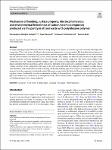Search
Author
- Eterigho-Ikelegbe, Ore... (1)
- Harrar, Hamza (1)
- Orevaoghene Eterigho-I... (1)
- Trammell, Ryan (1)
- next >
Subject
- CBW (1)
- PCD (1)
- simple mixing-pressing (1)
- SPR-212 (1)
- next >
Date issued
- 2023 (2)
Has File(s)
- true (2)
Search Results
Recycling coal-based waste (CBW) into composites suitable as a building material might be a necessary response to combat its risk to the environment. Therefore, the objective of this study was to investigate the microstructure and performance of coal composites produced from CBW and polysiloxane polymer (SPR-212). Four types of CBW that differ in physicochemical properties were examined. Fourier transform infrared spectroscopy results indicated that the higher the intensity of the C=C bonds in the CBW, the higher the pyrolysis mass loss and shrinkage experienced by the composites during pyrolysis. The continuous operating temperature of the composites is up to 600 °C. However, at temperatures above 600 °C, composites containing carbon content greater than 36% manifested dramatic deg... |
A simple mixing-pressing followed by thermal curing and pyrolysis process was used to upcycle coal waste into high-value composites. Three coal wastes of different physicochemical properties were investigated. The hypothetical mechanisms of bonding between the coal particles and the preceramic polymer are presented. The textural properties of the coals indicated that the lowest volatile coal waste (PCD) had a dense structure. This limited the diffusion and reaction of the preceramic polymer with the coal waste during pyrolysis, thereby leading to low-quality composites. The water contact angles of the composites up to 104° imply hydrophobic surfaces, hence, no external coating might be required. Analysis of the carbon phase confirmed that the amorphous carbon structure is prevalent ... |


